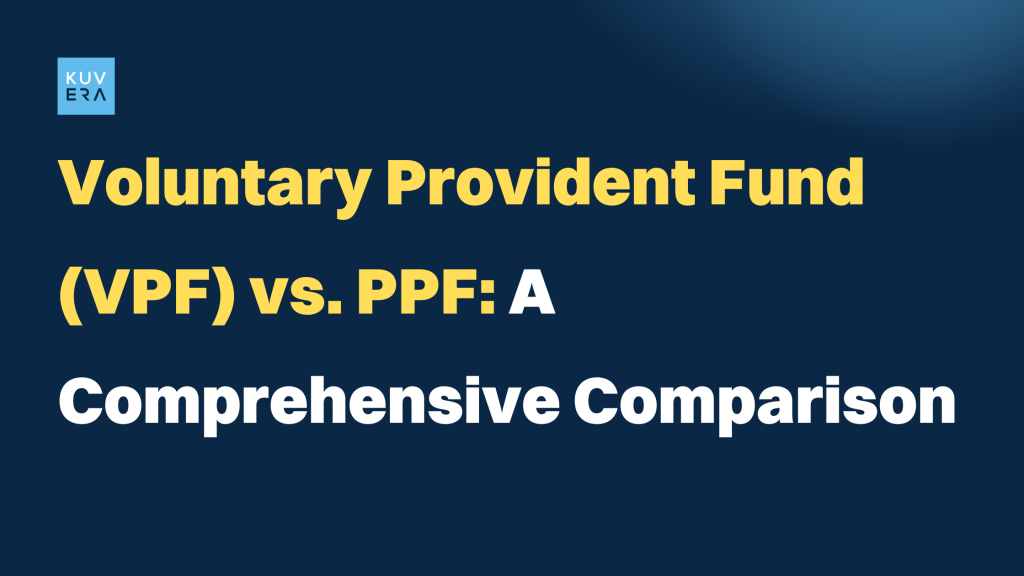In the realm of financial planning and securing your future, the Voluntary Provident Fund (VPF) and the Public Provident Fund (PPF) stand out as reliable options in India. Both offer avenues for long-term savings, tax benefits, and financial security.
In this comprehensive guide, we’ll explore VPF and PPF, highlighting their features, contribution limits, tax advantages, and suitability for your financial objectives.
Understanding Voluntary Provident Fund (VPF)
The Voluntary Provident Fund (VPF) serves as an extension of the Employee Provident Fund (EPF) and is aimed at salaried individuals eager to boost their retirement savings.
Here’s what you need to know about VPF:
1. Contribution Limit:
VPF enables employees to make voluntary contributions to their Provident Fund (PF) account, in addition to the mandatory 12% contributed to their EPF.
There is no fixed upper limit on VPF contributions, making it an attractive option for those looking to maximize their retirement corpus.
2. Tax Benefits:
VPF contributions are eligible for tax deductions under Section 80C of the Income Tax Act, subject to a maximum limit. The interest earned on VPF is also tax-exempt, aligning with the Exempt-Exempt-Exempt (EEE) tax status.
3. Liquidity:
VPF offers relatively lower liquidity compared to PPF, with limited withdrawal options.Withdrawals are primarily allowed for specific purposes like retirement, medical emergencies, or real estate investment.
Understanding Public Provident Fund (PPF)
The Public Provident Fund (PPF) is a government-backed, long-term savings scheme designed to provide financial stability.
Here’s what you need to know about PPF:
1. Contribution Limit:
PPF allows individuals to invest up to a predetermined limit, subject to annual revisions.Contributions can be made in lump sums or through regular monthly deposits, offering flexibility in saving.
2. Tax Benefits:
Contributions to PPF are eligible for deductions under Section 80C of the Income Tax Act. Interest income from PPF is entirely tax-free, in accordance with the EEE tax status.
3. Liquidity:
PPF offers better liquidity than VPF, permitting partial withdrawals after the completion of the sixth year. The PPF account matures after 15 years but can be extended indefinitely in five-year blocks.
Comparative Analysis: VPF vs. PPF
1. Returns and Interest Rates:
VPF often provides slightly higher interest rates compared to PPF, as they are linked to EPF interest rates. PPF interest rates are determined by the government and can fluctuate annually.
2. Liquidity and Withdrawals:
PPF offers more flexible withdrawal options, with partial withdrawals allowed from the seventh year. VPF imposes stricter withdrawal criteria, primarily focused on retirement and specific emergencies.
3. Tax Benefits:
Both VPF and PPF offer tax benefits under Section 80C, making them attractive for tax planning. Interest income from both VPF and PPF is exempt from tax.
4. Lock-in Period:
VPF lacks a fixed lock-in period, as it caters to an individual’s employment tenure. PPF has a fixed lock-in period of 15 years but can be extended indefinitely in five-year intervals.
Pros and Cons
Before making a decision, consider the following advantages and disadvantages of each investment option:
VPF Pros:
- Potentially higher interest rates than PPF
- No fixed contribution limit, allowing for substantial savings
- Instant linkage to EPF for salaried individuals
VPF Cons:
- Limited liquidity and withdrawal options.
- Primarily suitable for salaried individuals.
PPF Pros:
- Government-backed with a strong safety net
- Flexible contribution options and partial withdrawals
- Attractive tax benefits
PPF Cons:
- Lower interest rates compared to VPF
- Fixed lock-in period of 15 years
Conclusion
Both the Voluntary Provident Fund (VPF) and the Public Provident Fund (PPF) offer valuable avenues for long-term savings and financial security. Your choice should align with your financial goals, risk tolerance, and liquidity needs.
VPF excels in potential returns and suits those eager to maximise their retirement savings during their employment tenure. PPF provides greater flexibility in terms of liquidity and contributions, making it suitable for a broader range of investors.
By carefully assessing the features and your financial circumstances, you can choose the option that aligns best with your long-term financial objectives.
Disclaimer: The information provided in this article is for informational purposes only and should not be considered financial advice. Always consult with a certified financial advisor or tax consultant before making investment decisions.
Interested in how we think about the markets?
Read more: Zen And The Art Of Investing
Watch/hear on YouTube:
Start investing through a platform that brings goal planning and investing to your fingertips. Visit Kuvera.in to discover Direct Plans and Fixed Deposits and start investing today.

